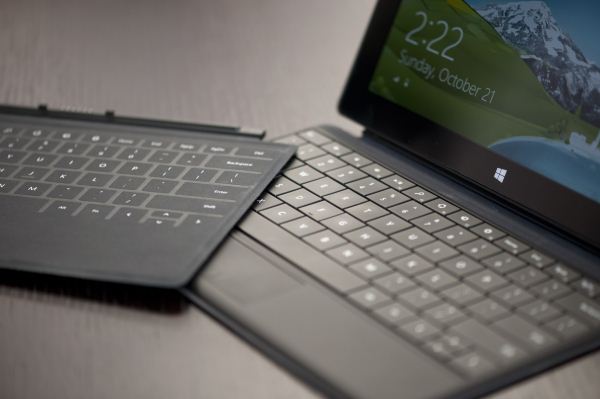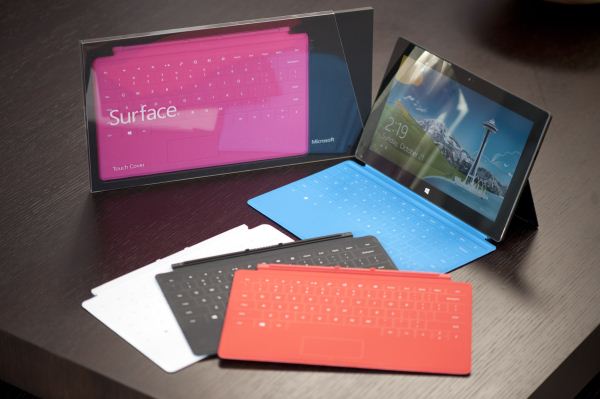
Original Link: https://www.anandtech.com/show/6385/microsoft-surface-review
Microsoft Surface Review
by Anand Lal Shimpi on October 23, 2012 9:01 PM EST- Posted in
- Microsoft
- Mobile
- Surface
- Tablets
- Windows RT
A Different Perspective
A week ago, I sat in an auditorium and listened to Steve Sinofsky talk about the tablet market. He talked about how the iPad was a great device, and a logical extension of the iPhone. Give iOS a bigger screen and all of the sudden you could do some things better on this new device. He talked about Android tablets, and Google’s learning process there, going from a phone OS on a tablet to eventually building Holo and creating a tablet-specific experience. He had nothing but good things to say about both competitors. I couldn’t tell just how sincere he was being, I don’t know Mr. Sinofsky all that well, but his thoughts were genuine, his analysis spot-on. Both Apple and Google tablets were good, in their own ways. What Steve said next didn’t really resonate with me until I had spent a few days with Surface. He called Surface and Windows RT Microsoft’s “perspective” on tablets. I don’t know if he even specifically called it a tablet, what stuck out was his emphasis on perspective.
I then listened to Panos Panay, GM of Microsoft’s Surface division, talk about wanting to control the messaging around Surface. He talked about how Microsoft’s June 18th event was scheduled because Surface was about to hit a point in its production where he could no longer guarantee there wouldn’t be substantial leaks about what the product actually was. He talked about the strict usage and testing guidelines everyone at Microsoft was forced to adhere to, again to avoid major leaks. He didn’t want Surface to be judged immediately and cast aside on someone else’s terms, because of some leak. Panos Panay wanted Microsoft to be the ones to bring Surface to market. Sure some rumors leaked about it before the June 18th event. A couple of weeks earlier, while I was in Taiwan, I even heard the local OEMs complaining about it (a lot of the “surprised” public outrage by Taiwanese OEMs was mostly politics). But for the most part, we didn’t know what Surface looked like and we had no concept of its design goals. Touch and Type Cover were both well guarded secrets.
I started off by recounting both of these stories for a reason. After using Microsoft’s Surface for the past week I can say that I honestly get it. This isn’t an iPad competitor, nor is it an Android tablet competitor. It truly is something different. A unique perspective, not necessarily the right one, but a different one that will definitely resonate well with some (not all) users. After the past week I also understand Panos Panay’s desire for secrecy. From a distance, without using one, Surface is easy to judge. It’s a Windows tablet that doesn’t run most Windows applications, that doesn’t have most of the same new mobile apps that iOS and Android have, and it’s not priced aggressively enough to make those facts disappear. After living with Surface however, I understand the appeal. It’s worth a discussion, perhaps even consideration as it does some things better than any tablet on the market, and it does others worse. Like all tablets (or smartphones even), there is no perfect platform, there are simply combinations of features and tradeoffs that resonate better with some users more than others. There are different perspectives.
Surface is Microsoft’s perspective. With the exception of some technical display discussion, Microsoft hardly mentioned the iPad in our Surface briefing. And when it did, it did so in a positive light. Microsoft isn’t delusional, the iPad is clearly a very well executed tablet. At the same time it believes there’s room for something else.
Surface: Simply Put
Surface is very well built and extremely well designed. It’s easily among the best built products I’ve had the opportunity to handle, and definitely puts a lot of earlier attempts from far more experienced companies to shame. I wouldn’t say that it looks better or worse than the iPad, it’s simply different. I talked about perspectives earlier, Microsoft’s perspective on tablets is a bit more utilitarian than Apple’s and Surface’s design reflects that reality.
Where the iPad is curvy and without any IO expansion, Surface is squared off with 22-degree beveled edges. The iPad features a light aluminum finish while Surface contrasts with its dark Magnesium surface. Not better or worse, just different.
Surface is both larger and heavier than the iPad, both design decisions on Microsoft’s part to built a device that could better deal with Windows RT’s multitasking capabilities as well as make room for a comfortable typing area when used with one of its two keyboard covers.
The added weight is offset by superb internal weight distribution. Microsoft claims a lower moment of inertia by more evenly distributing weight inside Surface’s chassis. I don’t know that I’d consider Surface light but it is very comfortable to carry around. It’s not quite like porting around a pad of paper, but carrying Surface feels very natural.
The focus on weight distribution results in a device that is honestly comfortable to hold in tablet mode and very comfortable to carry around. The more squared design of Surface actually makes in hand feel more like a book than the iPad, which was an early goal for the device.
The chassis is built out of an injection molded Magnesium, which gives it a very different feel to most machined Aluminum or plastic tablets we’ve used in the past. Microsoft calls this process VaporMg (vapor-mag) and I have to say that I’m pleased with the outcome. Surface’s finish is smooth and lacks the same texture that we’ve come to expect from machined Aluminum. The device feels very durable and doesn’t seem to scratch or scuff easily, although I didn’t purposefully try to mar my review unit over the past week. Striking a balance between robustness and light weight is very tricky business when building mobile devices, Surface easily falls on the robust side of the scale without feeling overly heavy. I never felt that the device was too fragile.
The power of Surface is in its flexibility. Microsoft’s talents not as a software developer nor as a parts assembler are what make Surface great here, rather its design and manufacturing intuition. I would’ve expected Surface to come from a company that had much more experience in designing and building tablets and PCs, not from a company that’s traditionally known for putting stickers all over them.
Surface’s flexibility comes from three areas: the tablet itself, the integrated kickstand and the optional Touch/Type covers. In tablet mode, Surface is Microsoft’s take on the new wave of tablets. It delivers the same intimate content consumption experience that you’d get from other tablets but with the added benefits of Windows RT, such as improved multitasking and better task switching.
Surface also features an integrated kickstand, also made out of the same VaporMg process as the rest of the chassis.
Microsoft wants you to be able to quickly transition between notebook, tablet and display modes. It’s rare that I see a goal so well executed. Surface really masters the art of quick transitions between all three modes. I can be in word, typing out this review and quickly switch to a tablet mode where I’m browsing the web with the keyboard cover folded neatly behind the display. If I need to respond to a comment or answer an email, I can just as easily switch back. The kickstand is a necessary part of enabling these quick transitions, and it does its job well.
There’s only one side of Surface that has a cutout for you to easily flick the stand out from its resting place. The kickstand’s range of motion does take some getting used to. It’s spring loaded enough to pop out at good velocity (and strong enough to pinch your skin nicely if you close it on a part of your finger by accident). When deployed it positions the top of Surface away from you at a 22-degree angle, matching the bevel of Surface’s edge.
With a fixed angle of deployment the kickstand doesn’t always deliver the best viewing experience, although it’s usually good enough. The kickstand is perfect for desk use and even for using while reclined on a couch or even in bed. Where it does fall short is if you’re hunched over Surface on an airplane in coach without a lot of room to move the device away from you. In those situations you’re going to find that you’d wish the kickstand could open at a wider angle.
Microsoft is particularly proud of the acoustics and feel of the kickstand. In my experience I felt the kickstand actuated nicely but I don’t know if I’d go so far as to draw the luxury car door comparison. The best way I can put it is the kickstand never feels cheap and doesn’t rattle, it works and gives you the confidence that it’ll always work and not just break after half a year. It’s not often that I find a substantial moving part on a mobile device that I feel is more functional than gimmicky. Surface’s kickstand is definitely a job well done.
The third element of Surface that makes it a very flexible device is also responsible for the splash of color in the design that gives the otherwise business appearance a consumer twist. I’m talking about Surface’s Type and Touch Covers.
Thing aka Touch Cover
Microsoft’s Touch Cover is an integral part of Surface’s design. Although it is physically separate, and even sold separately by default, Touch Cover is really a necessary part of Surface. The most obvious comparison is to Apple’s Smart Cover for the iPad. While I was relatively pleased with the iPad’s Smart Cover, Surface’s Touch Cover takes the magnetic cover concept to a completely new level.
The basics are, well, covered. Touch Cover doesn’t slip around or detach randomly, and since it’s one solid piece the cover tends to stay in place rather than flopping around.
Magnets in Touch Cover’s spine and in Surface’s base are much stronger than what Apple uses in the Smart Cover. The result is a connection that is strong enough to support the weight of the tablet when held by the cover. If you’re really daring you can even hold the Surface, suspended in the air by its Touch Cover and swing back and forth. Do it hard enough (especially if you add a vertical component to your movement) and you can get the two to detach, but the point is that the magnets are pretty strong.
Alignment is pretty simple, there are physical guides that try to make the two pieces mate perfectly but I found that early on I had to do some minor adjustments to the alignment to ensure a truly secure connection. Failing to do so usually resulted in me accidentally throwing Surface at the floor (once in the aisle of a crowded airplane at above 30,000 feet). The good news is Surface’s chassis and finish seem to hold up very well in unintended drop tests.
Touch Cover and Surface come together with a reassuring click. Part of the reason for using such strong magnets is because Surface actually powers Touch Cover. The proprietary six pin interface needs a good connection to transmit both power and data. Touch Cover input data is sent over I2C to Surface, the cover itself shows up as an I2C HID client.
Microsoft tells us that third parties will be able to build accessories for Surface’s custom connector however the spec won’t be open. Microsoft wants control over what accessories are made and how they interact with Surface. Having control over what connects to Surface gives Microsoft control over the quality of the ecosystem, but it also gives it a cut of accessory sales. Accessory makers have already engaged with Microsoft however nothing has been announced yet.
The Touch Cover integrates a pressure sensitive keyboard that requires around 40 grams of force to trigger a key press. Heavy typists will have no issues triggering each key, however if you’re a lighter typist then you’ll find yourself either missing the occasional keystroke or having to type a lot harder in order to guarantee accuracy. Unlike typing on a touch screen, there are no real concerns about finger placement. Each one of Touch Cover’s 77 keys is slightly raised and has a key pitch that resembles a standard, full size keyboard. Part of Microsoft’s decision to make Surface a 10.6-inch tablet was borne out of a desire to make Touch Cover a good approximation of a normal keyboard.
Surface’s Touch Cover features six rows of keys and doesn’t have any specific call outs for old school function keys, although there are dedicated keys for volume, home/end/page up/page down, etc… The function keys are still there however, just not labeled. To access them just hit alt + fn and then count the keys to the right of the escape key. For example, F4 is the fourth function key over, which on Touch Cover is the play/pause key.
There are some other quirks that take some getting used to. For example, there’s a capslock key but no capslock indicator.
Slight indentations on the F and J keys help you find your home keys easily and an oversized space bar helps improve typing accuracy. By and large the biggest issue is making sure you’re hitting the keys hard enough to register. Remember this is a pressure sensitive keyboard, and your fingers don’t always strike the keys with the same amount of force. Even if you do strike the keyboard evenly, positioning can be a problem. While Touch Cover is large enough to approximate a full sized typing area, there are slight deviations that make me sometimes miss hitting the control key or the spacebar. Microsoft attempted to address this issue by making the space bar’s pressure sensor much taller than normal, but I still found myself missing it from time to time. I do wonder if Microsoft would have a better experience if Touch Cover used capacitive touch sensors for the keys rather than pressure sensors.
Microsoft claims the Touch Cover keyboard can take four or five days of typing before touch typists can really get used to it. It’s still fundamentally a keyboard and I found the learning curve to be far less dramatic in practice. Unlike typing on a capacitive touch screen, the Touch Cover has a little bit of flex and give in its design. You don’t get nearly the key travel or tactile feedback of a traditional keyboard, but you at least get some of those things from the Touch Cover vs absolutely none via typing on a piece of glass.
Touch Cover is more than just a keyboard, it also features an integrated track pad. If there was a single biggest compromise in the design of the Touch Cover it would be the track pad. There’s simply not much room to include even a normal sized track pad, instead we get something that’s about the size of a track pad from a tiny netbook. The usefulness of the track pad really depends on your expectation levels. For occasional point and click work it is fine, but if you want it to be a full featured mouse replacement you’re going to be sorely disappointed. There are obviously no physical buttons so you’re forced to either tap on the already limited track pad surface area or use the little bit of space between the track pad and the edge of the cover as a virtual button. Again, for casual mouse work this isn’t a problem but try and drag something around with the track pad and the experience quickly falls apart.
The Touch Cover’s track pad supports two finger scrolling and one/two finger tap for left/right click but no other gestures. There’s simply not enough surface area to enable things like edge swipe without potentially interfering with normal keyboard use. The most maddening part about using Touch Cover’s track pad is the slight lag when trying to switch between two finger scroll and normal tracking. There’s a pause after you finish scrolling before the trackpad will respond to normal, single finger tracking inputs. Microsoft did this to avoid accidental inputs but in my opinion it’s too long of a delay.
Scrolling via the Touch Cover’s track pad is inverted by default with no option to reverse its direction. Similar to OS X Lion/Mountain Lion’s “natural scrolling” you can easily get used to the inverted track pad scrolling, it only becomes a problem if you frequently switch between devices that have normal scrolling. If you fall into that category, like yours truly, good luck. The inability to disable this feature is a bit perplexing since you can go into Control Panel and adjust most other mouse settings, including scroll distance. I tried poking around in the registry for a way to disable inverted scrolling but nothing stood out to me.
Although it has a functional purpose as an input device, Touch Cover also works very well as a cover. The outer surface is a dense felt on the black cover, and a soft polyurethane on the colored versions. The result is a device with a good balance of high tech and natural in hand feel. The 3.2mm extra thickness that Touch Cover adds is barely noticeable and is honestly worth it given the productivity benefits. With the exception of the occasional input in tablet mode, I see no reason to even use the on screen keyboard if you’ve got Touch Cover. Touch Cover only protects Surface’s cover glass, the rear remains exposed, but the VaporMg chassis seems fairly durable to begin with.
Microsoft offers Touch Cover in five colors black, white, magenta, cyan and red. The black touch cover is available in a $599 bundle with a 32GB Surface, or you can buy Touch Covers independently for $119.
At the end of the day I’d say Touch Cover is a great step above a screen-based capacitive keyboard. Touch typing isn’t an issue at all thanks to the fact that this is still a physical keyboard with actual feel to the keys. The biggest issue is accuracy with some of the pressure sensors not responding when you hit them. The easiest way to control that is to increase the force of all of your taps although I suspect that with time you could train your fingers to individually apply the right amount of force. There’s a balance between speed and strike force. I found that I could be fairly accurate if I just slowed my pace down. If I wanted to type closer to full speed, I could compensate by increasing the strength behind my taps.
Touch Cover really is an integral part of the Surface experience. I would say that it’s perfect for moderate typing use. Although I wrote half of this review on Touch Cover, I preferred using the Type Cover which I used to type the second half. Touch Cover can get the job done in a pinch, but it’s clearly built for folks who don’t have to type 5 – 10K word documents.
Type Cover
If Microsoft’s Touch Cover is the perfect companion for occasional typing, its Type Cover is the professional counterpart. Thickness increases by roughly 2.2mm, enough to be noticeable while still maintaining the svelte profile of Surface, but in exchange for marginally more bulk you get a keyboard with actuating scissor keys.
The keys themselves are a little bigger than in Touch Cover, thus reducing the amount of empty space between each key, but overall the feel is very similar. Where Type Cover really delivers is in its use of scissor keys. If you want more of a notebook feel, this is the way to go.
Typing quickly on Type Cover isn’t fatiguing at all and it’s just as easy to write large documents or emails using it as it would be on a traditional notebook. There are very few tradeoffs that you make to enjoy Type Cover. There’s only one color (black), and of course there is some additional thickness. The keyboard itself isn’t perfect but it’s good enough to write this review on.
I actually wasn’t bothered by the relatively shallow keystroke depth on Type Cover, although I am very used to the relatively shallow feel of most ultraportable keyboards by now. If you’re expecting the same sort of keyboard as you’d find on a thick mainstream notebook, you will be disappointed.
Type Cover’s trackpad is marginally better than what you get with Touch Cover. The trackpad is actually a tiny, top-hinged clickpad, which makes clicking a bit easier. Tap to click and two finger scrolling are both supported. The trackpad surface isn’t particularly smooth, and it isn’t all that large of a surface which work together to make scrolling nice and frustrating. The lower right section of the trackpad serves as a physical right mouse button.
Type Cover sells at a $10 premium to Touch Cover. At $129 it isn’t cheap, but it’s likely the option anyone who is going to do a lot of typing will need to take to get the most out of their Surface RT tablet.
My only complaint with Type Cover was that it would randomly stop accepting keystrokes in mid sentence, sometimes even in the middle of a word. I’m not entirely sure what’s going on, whether I’m hitting performance limitations and the platform is just dropping keystrokes or if there’s a physical problem with my unit (or Type Cover in general), but it was annoying. Even with the occasional dropped keystrokes I was still able to type faster and better on Type Cover than I could with Touch Cover. If you write for a living, you can live with Touch Cover, but you’d probably rather have Type Cover. Neither is as good as a traditional notebook keyboard, but both are light years ahead of typing on a glass screen.
Display: Not Retina, But Still Good
Surface features a 10.6 inch, 1366 x 768 16:9 display. The physical size is a bit unusual, although the display resolution is something we’ve seen used in affordable notebooks for years now. We already know why Microsoft picked the display size (to enable better multitasking and make for a good keyboard size), but is there room for a flagship tablet with only a 1366 x 768 display resolution?
Microsoft’s response to the resolution question is that more pixels isn’t necessarily better, and that there are a number of other factors that are just as important. It also is quick to point out that a significantly higher resolution display would have increased memory bandwidth requirements, decreased UI frame rate and required a larger battery. As NVIDIA’s Tegra 3 only has a single channel LPDDR2 memory interface, driving a 2048 x 1536 panel and maintaining Microsoft’s UI performance requirements was out of the question. Apple ran into the same issue and ended up building the A5X SoC with an insanely wide memory interface to deal with it. Down the road I’d expect the memory bandwidth problem to get solved, but that still leaves a power consumption issue. Apple moved to a 42.5Wh battery in the 3rd generation iPad, a 37% capacity increase compared to the 31Wh unit in Surface. Enabling a similar panel would have pushed size and weight of Surface more than Microsoft would have liked.
Given those constraints Microsoft chose a different route with Surface. Rather than focus on pixel density it focused on improving contrast and reducing glare. Surface laminates the cover glass and LCD panel together, removing an annoying air gap that’s responsible for some reflections/glare and a reduction in brightness. Apple’s recently announced 8th generation iMac does something similar, as do a lot of high end smartphones, but Surface is among the first to do so with a ~10-inch LCD. The effect is noticeable in a contrived photo but it also results in a display that’s not half bad to look at.
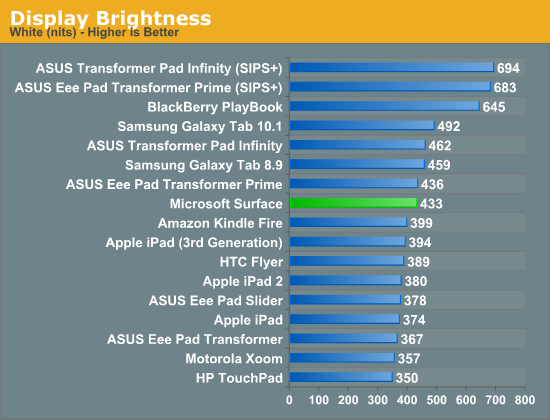
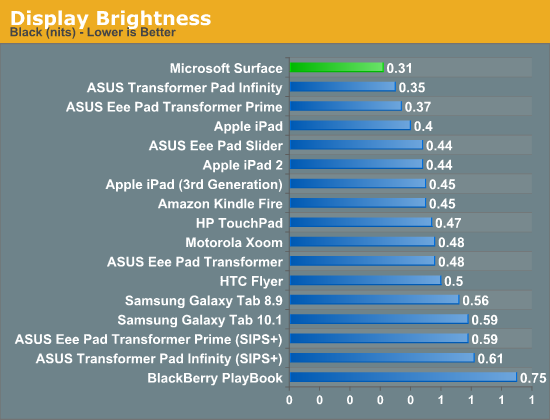
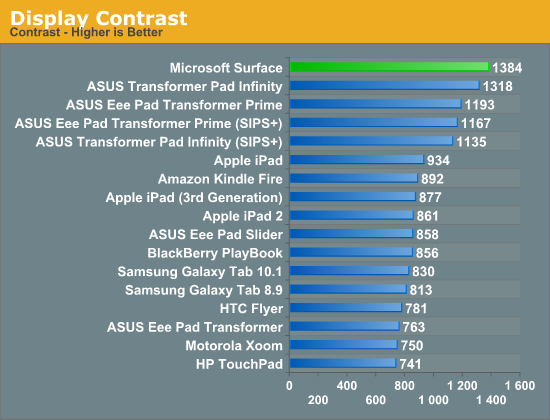
With the exception of text on web pages, the lower resolution Surface display isn’t overly bothersome. I would like something a bit higher resolution although I don’t know that matching Apple’s pixel density is absolutely necessary if Microsoft can deliver elsewhere.
Apple doesn’t just rely on resolution to sell the iPad’s Retina Display, it also happens to do quite well at accurately representing colors. I put Surface through AnandTech Senior Display Editor, Chris Heinonen’s excellent tablet/smartphone analysis workflow to see how well it did:
| CalMAN Display Comparison | ||||||
| Apple iPad (3rd gen) | Apple iPad 2 | ASUS Transformer Pad Infinity | Microsoft Surface | |||
| Grayscale 200 nits Avg dE2000 | 3.7333 | 1.3826 | 3.9881 | 3.6769 | ||
| CCT Avg (K) | 6857K | 6632K | 6632K | 6407K | ||
| Saturation Sweep Avg dE2000 | 3.193 | 6.8404 | 6.8404 | 7.3617 | ||
| GMB Colorchecker Avg dE2000 | 3.0698 | 3.8957 | 4.4177 | 5.3057 | ||
Saturation

Gamut
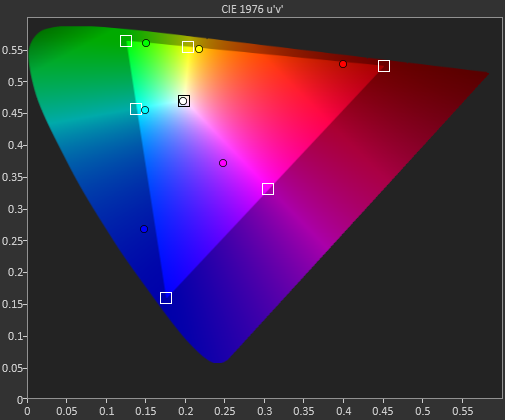
GMB Color Checker
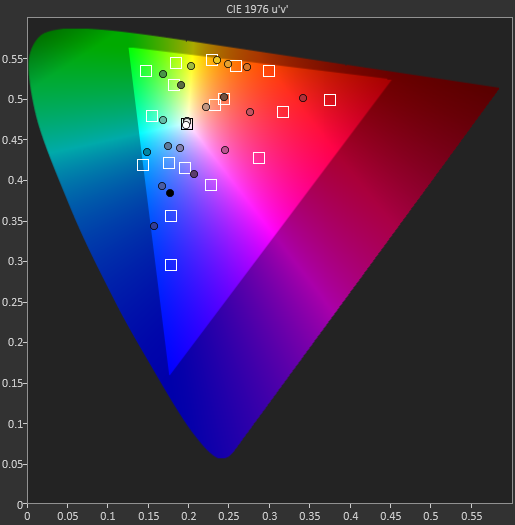
Grayscale accuracy is slightly better on Surface compared to the iPad, however the rest of the accuracy metrics show Apple’s tablet ahead of Surface.
This isn’t to say that Surface’s display is bad, in fact I think it’s quite good and I’d argue that it was never a problem in my testing, but it’s definitely not the best on the market today. I’m also not sure how much of this has to do with Microsoft’s panel selection vs. software calibration. None of my calibration tools work under Windows RT so I couldn’t really tell you.
I did reach out to Microsoft and they did say that some of my values in the charts below looked a little off. I’ll be rerunning data on another Surface sample as soon as I get a chance to.
A Plethora of Ports and Storage Options
One area where Surface is a significant departure from the iPad is in its IO and expansion. The iPad features a single dock (and soon to be Lightning) connector, while Surface looks more like a laptop (or Android tablet) when it comes to IO.
There’s no port for syncing, you get content onto Surface via WiFi or a more traditional method. Surface has a single USB 2.0 port on the right side of the device. You can plug almost anything you want into this port, including USB storage devices of course. Behind the kickstand is a single microSD card slot, giving you another option for expansion.
On the left edge of the device there’s a micro-HDMI out port that can be paired with a Microsoft made VGA or HDMI dongle (both dongles have a 22-degree connector on them to mate flush with Surface). I tested HDMI output with Microsoft's dongle and unfortunately the result wasn't very good. The 1080p output had a lot of issues with scaling quality (as you can see from the shot below) and there was a lot of tearing on the screen with a big impact on UI frame rate. I reached out to Microsoft for an explanation but have yet to hear anything.
Finally there’s a standard 1/8” headphone jack along the top of the device.
Power delivery comes via a custom magnetic connector along the lower right side of Surface.
Given that the internal storage is an eMMC solution, performance from the microSD slot with a good card should be fairly comparable. In practice I could read and write a large sequential file at roughly 10.5 MB/s using a SanDisk microSD card.
Copying from a fast USB stick to Surface’s internal storage gave me transfer rates closer to 17MB/s. There are a few vendors for Windows 8/RT eMMC devices, I’ll be paying close attention over the coming weeks to figure out who makes the best. I know Microsoft and Intel (among others) have been playing close attention to the eMMC providers with hopes of weeding out those that deliver honestly unacceptable performance.
While doing background file IO I didn’t notice any of the stalling/pausing that we’ve seen on some of the more recent Android tablets.
Update: Many have asked about how much storage is taken up by the Windows + Office 2013 installs. The screenshot below shows the directory size for both C:\Windows and C:\Program Files, the latter is where the Office15 install files are included (and yes winword.exe is still the Word executable).
You're looking at roughly 6.47GB for Windows RT and then another 830MB for Office for a grand total of around 7.3GB.
USB Compatibility
Microsoft is particularly proud of its single USB 2.0 port on Surface. Although USB ports have been featured on several Android tablets, their support was typically limited to flash drives, keyboards and mice. With Windows RT, Microsoft wants to bring more of the traditional Windows experience to tablets. Had Surface been x86 based, you would be able to plug in virtually any USB peripheral and it would just work. As the first version of Surface is based on an ARM SoC, driver support is a little more limited but still pretty decent.
USB drives obviously work as you’d expect them to. Even SATA to USB adapters worked fine when plugged into Surface. Other smartphones and tablets also worked, although their level of support varied. For example, you can plug in the iPhone 5 and have it come up as a supported device for moving pictures to/from. However USB tethering is not supported by the class driver included in Windows RT. You can even plug an iPad into Surface and get the same level of support.
Printer support is pretty decent, although the Epson Workforce 910 I tried didn’t actually have specific driver support under RT. Although development for the desktop side of Windows is limited, manufacturers can supply Windows RT drivers to enable support for some more obscure devices. Unfortunately when it comes to those devices you’ll have to play the waiting game as there’s simply not a lot of third party Windows RT drivers available for download today.
WiFi Performance
Microsoft made an unusual choice for Surface’s WiFi hardware, it uses a Marvell AVASTAR dual-band MIMO (2x2) 802.11n wireless network controller (88W8797?). Marvell tends to be one of the more cost effective players in the industry which could help explain Microsoft’s choice.
Despite the rarely used silicon, WiFi range on Surface is quite good. Subjectively I was able to hold on to 2.4GHz signals at greater distances than I could on both the 3rd gen iPad, ASUS’ Transformer Pad Infinity and even compared to the VivoTab RT based on some short time I had with the device. Surface also maintains good distances on 5GHz however the performance drop offs are far more significant.
The sweet spot for Surface’s WiFi appears to be around 40 feet away from an AP, with minimal obstructions (doors/walls are fine). Within this range in my testing I was able to maintain speeds of around 20 – 40Mbps. Add another 20 or so feet and you’ll see performance cut in half again.
Although range is good on Surface, at the outer edges of coverage you’re looking at 2 – 4Mbps, which is only really enough for casual web browsing.
The only real downside to Surface’s WiFi performance is its peak performance. I wasn’t able to get beyond 42Mbps when copying files to the device from a local server on the network. It’s possible that I was limited by some file sharing protocol overhead, but without a good suite of network performance tools for Windows RT it was the best I could do for now.
Camera
Surface features two 720p cameras, one on the front and one on the back. Neither camera provides particularly great image quality but they are sufficient for web use.
The camera UI is quick and fairly simple. Tap and hold to lock exposure is supported, and you can tap anywhere on the screen to actually take a photo. Switching between front and rear facing cameras is quick, as is switching between photo and video modes.
The only aspect of Surface’s cameras that takes some getting used to is the 22-degree angled camera assembly on the back. The angled rear facing camera is designed to offset the inline created by the kickstand when deployed, so you can prop Surface up on its kickstand and not have the rear camera pointing at the ground. Unfortunately when handheld it means that you often have to tilt Surface a bit to get the right shot. I guess that’s better than having the rear facing camera pointing at the ground when used the kickstand deployed, but that likely depends on what you’re using Surface’s rear camera for.
Battery Life
Surface features an integrated 31 Wh battery, which is larger than what’s in the iPad 2 but smaller than what Apple used for the iPad 3. Charging duties are handled via a 24W power adapter with a custom magnetic connector.
Of all of the aspects of Surface, the charging connector feels like the least well executed. For starters, the connector is quite long – about twice the length of a MagSafe connector. Secondly, the magnets in the connector aren’t all that strong so the attraction to Surface isn’t very confidence inspiring. The third issue is alignment. Because of the 22-degree beveled edge on Surface, you have to approach mating the power connector to the tablet very carefully. More often than not I’d have the connector match up but not fully connect. It usually required a few minor adjustments to get the connector to actually start charging. My final complaint is about the power indicator LED on the connector itself. The LED only glows white and gives no indication of whether or not the device is done charging. Furthermore, it doesn’t even glow all that bright, making it hard to tell in daylight whether the device is even getting power. I’m pleased with virtually all aspects of Surface’s physical design, but the charging port and connector need to be redone for the next generation.
The power adapter itself is larger than the 10 – 15W units you get with most tablets in this price range, but it is also a considerably larger power supply. You can take Surface from completely empty to fully charged in a little over 3 hours hours. You can also get Surface up to 50% power, while using the device, after just over an hour of being plugged in. Microsoft wanted to prioritize real world productivity scenarios where you had a limited amount of time to charge but also needed to use the device. The larger power adapter and not gigantic battery were the right balance to meet those needs.
The power brick features a Windows RT logo, but is otherwise clean. The surface of the adapter is a nice soft touch plastic. The two prongs for US models stow away neatly in the adapter. The power cable is nice and long at around 1.5m. There’s no built in cable management other than a little U to keep the connector attached to the end of the cable.
To measure battery life I put Surface through our 2012 tablet battery life suite. All tests were run with the display calibrated to 200 nits and with Surface, its Touch Cover was attached.

Overall battery life is pretty competitive with the iPad. In lighter use cases Apple pulls ahead slightly, but if you look at our updated web browsing test the heavier CPU load pushes Surface ahead of the third gen iPad. It’s not clear how the 4th gen iPad would stack up in this comparison.

Video playback is also decent for Surface, although Apple manages to pull ahead with the win there as well. The bigger accomplishment is that we’re seeing a Windows device with battery life that’s comparable to other tablets running mobile OSes designed from the ground up.
Microsoft has the right OS platform to be competitive in this space. With some more power efficient hardware I could see a future iteration of Surface moving its way up these charts.
Performance
There are two aspects to Surface’s performance that we need to discuss: the user experience and then quantitative performance metrics.
User experience is equal parts hardware and software, and this is one area where Microsoft really delivered with Windows RT. Frame rates are solid and stable, easily delivering what appears to be 60 fps for UI transitions. If you try to push the hardware too much, RT seems to completely drop animations vs. animating choppily which seems to be the right tradeoff to make. Overall that doesn’t seem to happen all that frequently.
Scrolling down web pages is also very smooth, although you can get IE to behave very jittery if you hold your finger in the wrong place on the screen while scrolling. There are some rough edges with the RT UI but overall it’s still very good.
I’d say in terms of smoothness of UI, Windows RT on Surface is much more like the iPad (or Windows Phone 7.5) than most Android tablets. Jelly Bean does complicate things as it really fixes a lot of the UI performance issues that hampered Android. Even then I’d say Surface’s UI responsiveness is among the best.
Application launch times are another thing entirely. Nearly every application I launched took longer than I would’ve liked on Surface. I can’t tell if this is a hardware issue or a software optimization problem, but application launches on Surface/Windows RT clearly take more time than on an iPad. I timed a few just to put this in perspective:
| Application Launch Time Comparison | |||||||
| Boot | Web Browser | Maps | Games Center / Xbox | ||||
| Apple iPad (3rd gen) | 32.0s | 1.0s | 2.4s | 1.1s | 1.9s | ||
| Microsoft Surface | 27.7s | 2.6s | 7.1s | 5.0s | 5.0s | ||
Now once apps have been launched, switching between them using Windows RT’s excellent multitasking system is just awesome. Apps fly in with little to no lag and the process is just great.
The only other user experience issue I have with Surface has to do with CPU utilization when using Office 2013. Surface, like all Windows RT tablets, comes with a free installation of Office 2013 Student & Home Edition. Surface also happens to use a quad-core NVIDIA Tegra 3 SoC, featuring four ARM Cortex A9 cores running at up to 1.3GHz. At least for the Cortex A9 generation, I don’t know that Microsoft could’ve used anything slower. Simply typing quickly in Microsoft Word maxes the single threaded performance of Tegra 3’s ARM Cortex A9 cores. I’ve seen CPU usage a high as 50% when typing very quickly, but mostly it tends to sit between 20 – 40%. Switch to notepad and max CPU utilization drops to sub 10%. This says more about Office 2013 than the performance of NVIDIA’s Tegra 3, but there are not a whole lot of spare CPU cycles to go around with Surface.
This brings us to the next part of the performance discussion: quantitative performance analysis. Windows RT/8 will likely bring balance to the tablet benchmark scene, but all of the folks currently working on benchmarks are targeting a late 2012/early 2013 release. We will eventually see everything from PCMark to GLBenchmark ported to Windows RT, but until then we’re left in the same situation we have under iOS: relying on JavaScript benchmarks to characterize performance.
With only two Windows RT tablets in our possession (ASUS’ VivoTab RT and Surface), this section would be pretty bare. To rectify this problem I phoned a friend who let me borrow a soon to be released Clovertrail (Atom Z2760) based Windows 8 tablet. To avoid getting in trouble with the specific manufacturer of this tablet I’ll refrain from posting photos or calling out the device by name, but we’ve talked about it on the site before.
As a recap, Clovertrail is the x86 alternative to ARM for Windows 8 tablets. The Atom Z2760 integrates two 32nm Saltwell cores running at up to 1.8GHz. Each core is Hyper Threaded so the entire SoC can work on four threads at a time, similar to NVIDIA’s Tegra 3. The GPU is Imagination’s PowerVR SGX 545 running at 533MHz. The SoC features a dual-channel LPDDR2 memory interface. NVIDIA’s Tegra 3 has a single channel LPDDR2 interface running at a 1500MHz data rate in Surface.
On the user experience side alone, the Clovertrail tablet is noticeably quicker than Surface. Surface isn’t slow by any means, but had it used Atom hardware it would’ve been even more responsive.
Putting all of this into numbers, we have a collection of JavaScript performance tests, some of which were used in the iPhone 5 review. Note that all of these tests were run using IE10 in Windows RT/8 thus making the comparison less about software and more about hardware differences:
| JavaScript Performance | |||||||
| Time in ms (Lower is Better) | Kraken | SunSpider | RIA Bench Focus | ||||
| Intel Atom Z2760 | 33855.7ms | 714.9ms | 3872ms | ||||
| Microsoft Surface (Tegra 3 1.3GHz) | 49595.5ms | 981.1ms | 5880ms | ||||
Across the board Clovertrail manages a 30 - 50% advantage over Tegra 3. Granted we’re not looking at power consumption here, but the Clovertrail tablet I’m comparing is even smaller/lighter than Surface for what it’s worth. We’ll have battery life numbers for it in the coming weeks.
Principled Technologies, apparently featuring some of the same folks who were responsible for building the old Winstone benchmarks from over a decade ago, actually put out the first cross platform Windows RT/8 benchmark with some help from Intel. Despite Intel’s influence the test appears to have no native code, instead relying on just a heavy workload of large images and videos for its tests.
| TouchXPRT 2013 | |||||||
| Time in Seconds (Lower is Better) | Photo Enhance | Photo Export | Video Transcode | MP3 Transcode | Photo Slideshow Creation | ||
| Intel Atom Z2760 | 210.83s | 73.93s | 53.91s | 98.66s | 85.81s | ||
| Microsoft Surface (Tegra 3 1.3GHz) | 306.12s | 116.36s | 87.27s | 160.99s | 125.06s | ||
| ASUS VivoTab RT (Tegra 3 1.3GHz) | 312.14s | 109.89s | 89.69s | 155.84s | 122.65s | ||
The large files used in the workload do a great job of showing Atom’s memory controller advantages over that used by the Cortex A9. The results here likely overstate the Clovertrail performance advantage a bit (I’m not sure how much 1080p video transcoding you’re going to be doing on Surface as compared to web browsing) but the results tend to agree with what our browser based JavaScript tests show: Intel’s Atom Z2760 is considerably faster than Tegra 3 here.
I understand that Microsoft needed a good launch vehicle for Windows RT, however I really would have liked to have seen an Atom version of Surface. An Ivy Bridge version is in the works, but it’s also a bit larger. An Atom version could retain the same chassis size/weight, but deliver tangibly better CPU performance. Again we’ll have to wait to see what battery life looks like for these Clovertrail tablets before really deciding whether or not Atom would’ve been a better fit.
Windows RT
I’m not going to go into a super deep look at Windows RT here as we have a separate review for just that purpose. Instead I’m going to talk about the highlights as they apply to Surface.
There’s a definite learning curve to Windows RT/8. It doesn’t matter what OS you’re coming from, even if it’s Windows, it’s going to take some time to get used to the new Windows UI. Once you do however, you’ll see that it really was made for tablets and touch.
Switching between applications is faster on Surface/Windows RT than any competing mobile platform. There’s no double tapping of anything, no pressing and holding, just an edge gesture swipe like you’re flipping through pages of a virtual book. Apple's four finger swipe to move between apps on the iPad is the closest competitor here, but the edge swipe in RT is a bit more natural.
Activating the task switcher takes some getting used to, but once you do it’s much better than the alternatives.
The other big advantage that Windows RT brings to the table is the ability to display two applications on the screen at the same time. The options are fairly limited. You can have one app take up the majority of the display, with a second application limited to a narrow strip of real estate on either the left or right of the screen, but it’s better than only being able to show one thing at a time. Not all applications work well in this screen sharing setup, but it’s great for things like keeping an eye on email while browsing the web, or watching Twitter while playing a movie. Microsoft is definitely ahead of the curve when it comes to bringing true multitasking to tablets.
The charms bar (edge swipe from the right side of the screen) also gives Windows RT/8 the perfect mechanism for getting access to settings. The settings screen always gives you access to basic things like connecting to WiFi, adjusting screen brightness, turning rotation lock on/off, powering down the tablet, etc... But activate it while you’re in an app and you’ll get access to that application’s individual settings. It sounds simple but it’s consistent and easy to get to.
The other big benefit of Windows RT is you still get a desktop mode. If you want to tinker with things like scrolling speed or if you want direct access to the underlying file system, you still get those things. Windows Explorer exists and RT is installed in the same C:\Windows directory that we’ve been looking at for years. Want to dump photos from a USB stick into your photo library? You can just copy them as you always would using Explorer. You get a command prompt, you can write and run batch files, you get access to diskpart and can even manually TRIM the integrated NAND storage. Did I mention you can even tinker around in the registry? Not everyone will care about these things, but I get a kick out of them. Windows RT/8 is an almost perfect marriage of new mobile world simplicity with the flexibility that we’ve enjoyed from Windows for ages.
Using the desktop mode with touch isn't ideal, but it ends up being more usable than I expected going into the review. I was able to do things like activate buttons, resize and move windows around using touch alone without much struggling.
Although we've seen issues with new tablet platforms and an absence of apps, I don't believe this will apply to Windows RT/8. The Windows Store will be available on all Windows RT and Windows 8 devices, giving developers a nice and hefty install base over the coming year. While the state of 3rd party apps on the Windows Store today is pretty dire, I do believe this will change in short order.
The only things missing are backwards compatibility with older x86 apps/drivers and the ability to install apps for desktop mode (only Metro, err new Windows UI apps are supported by Windows RT). The lack of backwards compatibility is a bit of a concern, but if you’re cross shopping between Surface and an iOS/Android tablet you’re not going to get backwards compatibility anyway making it a non-issue.
Pricing and Final Words
Last week Microsoft announced pricing for Surface. The base configuration starts at $499 with 32GB of internal storage, you can get a bundle with a black Touch Cover for $599 and finally there’s a 64GB model with Touch Cover for $699. All versions of Surface come with Office 2013 Home & Student Edition preview, and will be upgraded (for free) to the final build of Office 2013 once it’s available.
Whether or not Surface is priced appropriately really depends on how much you value Windows RT and getting Office 2013 for free. I suspect if you’re already a big Office user, you’ll see a lot of value in the bundle. On the Windows RT side, whether or not that platform has value really depends on how frustrated you are by the multitasking, task switching and lack of screen sharing (two apps on the screen at once) of other mobile OSes. Depending on your feelings on those two issues Surface will either feel like a bargain, or too much.
As a device, Surface is incredibly well executed. It makes sense that Microsoft’s OEM partners are feeling the pressure as there’s very little that I would change about Surface from a design perspective. The chassis is well built and the integrated kickstand is seriously one of the most useful features to ever meet a tablet. The optional Touch and Type Covers complete the package. While a full sized notebook is going to deliver a better typing experience, when paired with its Touch/Type covers Surface results in a more productive platform than any other tablet.
Surface is the most flexible tablet I've ever used. Through two seemingly simple additions to the design (but incredibly complex to actually develop and implement), Microsoft took a tablet and turned it into something much more. If you're frustrated by productivity limits of currently available tablets, Surface really seems to be the right formula for a solution. It's important to note that Microsoft's execution with Surface establishes the company as a competitive powerhouse in the mobile design market. I can only imagine what multiple revs of the design will give us, not to mention what could happen if Microsoft set its obsessive sights on smartphones or notebooks.
The Windows RT experience, in many senses, is clearly ahead of what many competitors offer in the tablet space today. Multitasking, task switching and the ability to have multiple applications active on the screen at once are all big advantages that Microsoft enjoys. For productivity workloads, Surface is without equal in the tablet space.
Content consumption is also great on the device. Surface's display isn't industry leading but it's still good. Reading emails, browsing the web flipping through photos and watching videos are all good fits for the platform - just as good as competing solutions from Apple or Google.
More impressive than the fact that Microsoft brought competitive parity to the Windows tablet usage model is the fact that power efficiency doesn't seem to be an issue for Windows RT. Microsoft has built a mobile OS that is capable of, at least based on what we've seen today with Surface, being competitive with Android and iOS solutions when it comes to battery life. With lower power silicon inside, Microsoft could do even better.
I don't believe Surface is perfect, but it's a platform I can believe in. What I'm most excited about is to see what happens after a second or third rev of the design. I would have liked to have seen faster hardware inside (I'd love to see an Atom based version). There are also some rough edges that could use smoothing out (e.g. the power connector and HDMI output come to mind) and Windows RT likely needs another round of updates (app launch times are far too long, more apps needed) but overall the device is easily in recommendable territory. The biggest issue I have with recommending Surface today is that you know the next iteration of the device is likely going to be appreciably better, with faster/more efficient hardware and perhaps even a better chassis.
If you're ok being an early adopter, and ok dealing with the fact that mobile devices are still being significantly revved every year, Surface is worth your consideration. If you've wanted a tablet that could begin to bridge the content consumption and productivity divide, Surface is it.

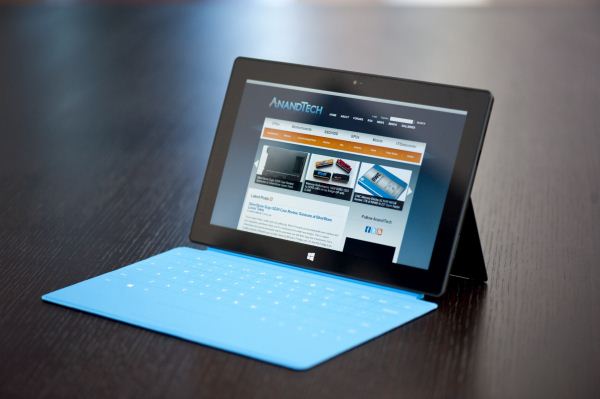
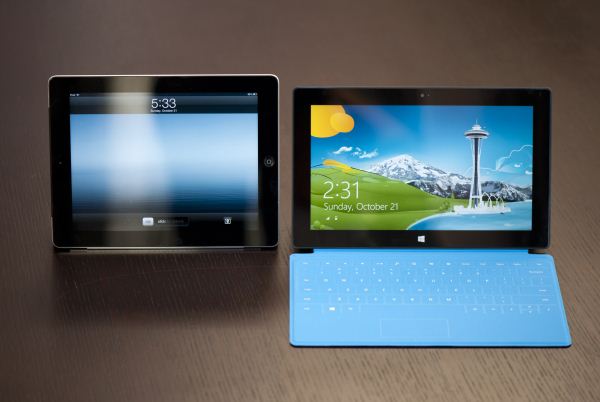
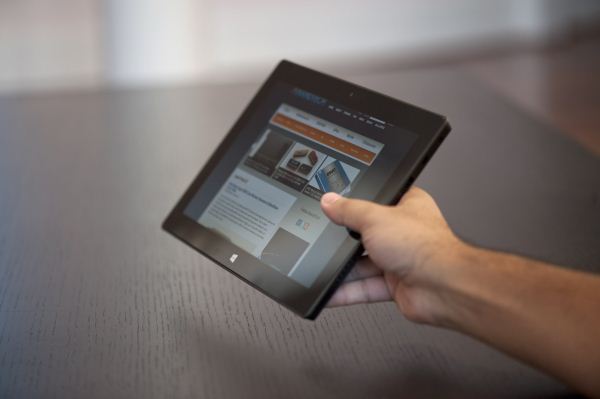






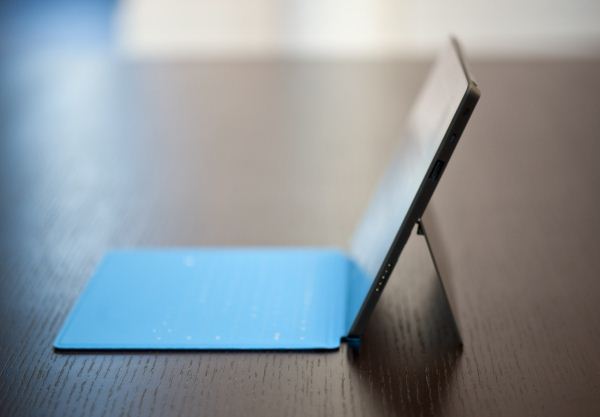
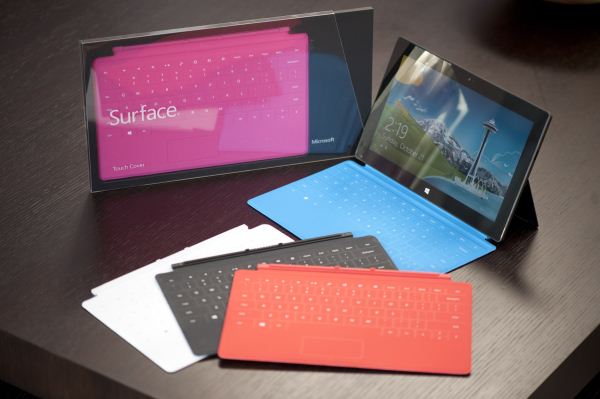
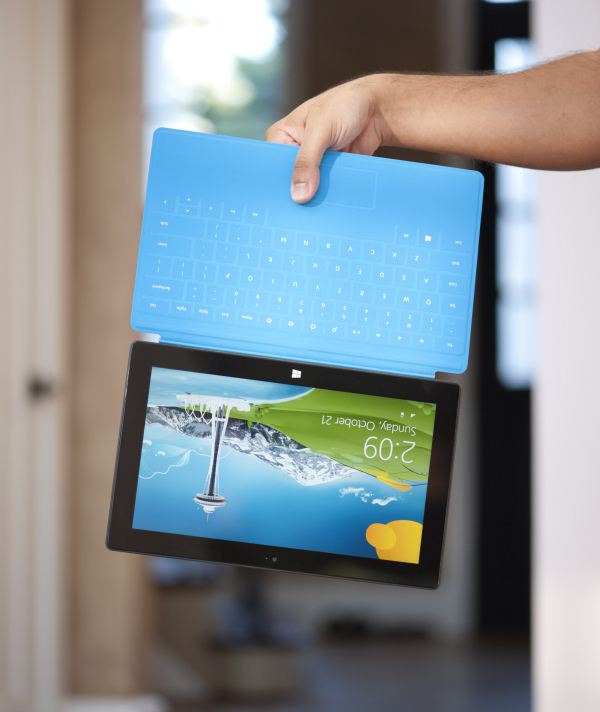
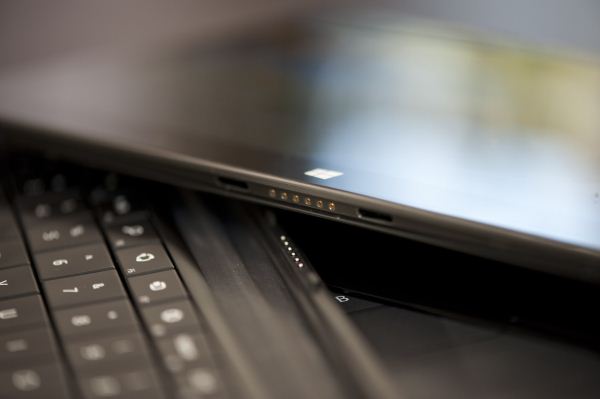
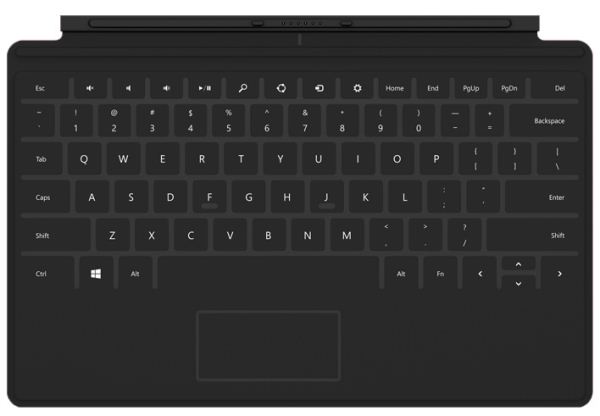

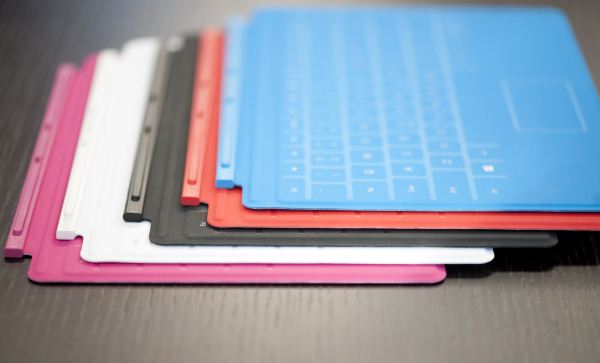






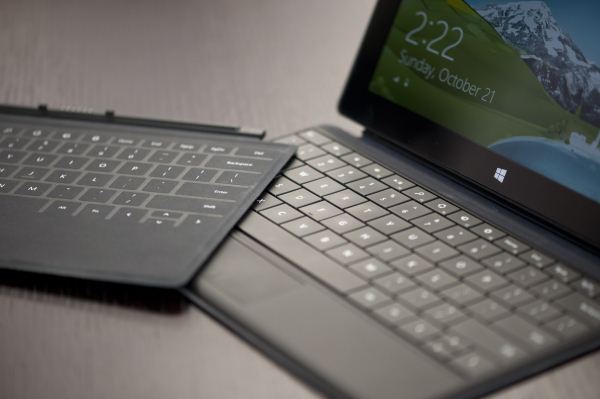

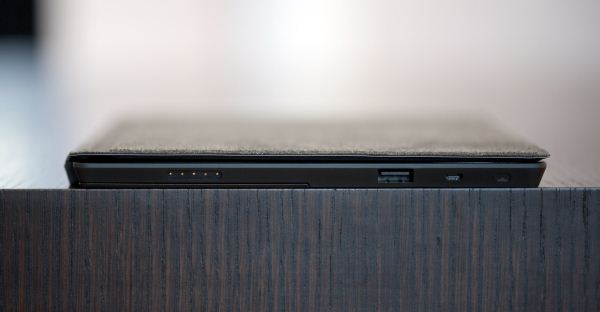



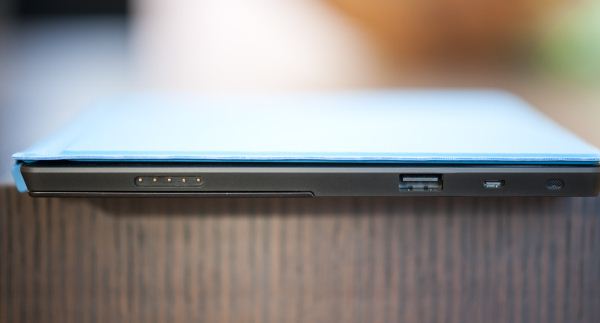
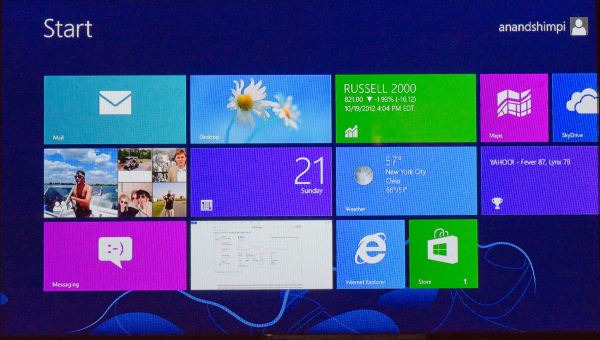
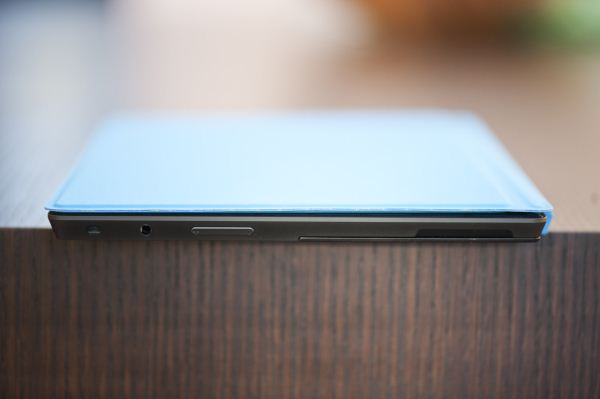

_575px.png)
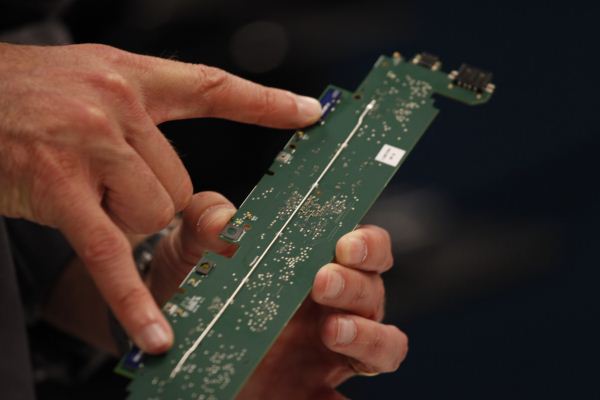







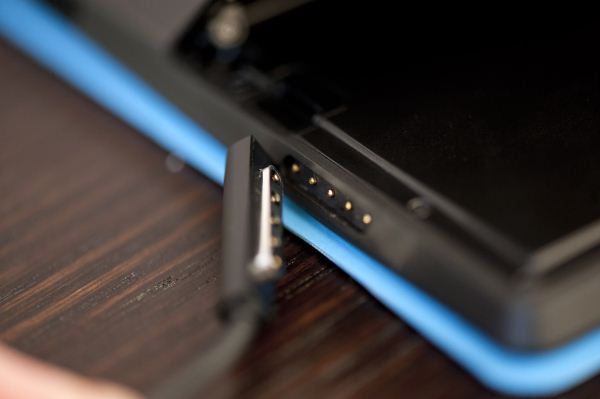


_575px.png)
_575px.png)
_575px.png)
_575px.png)
_575px.png)
